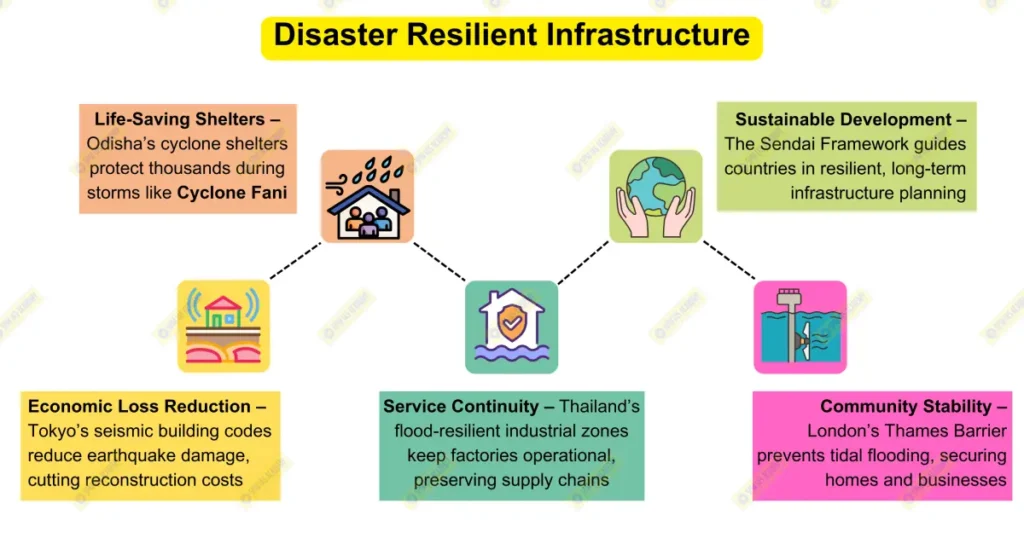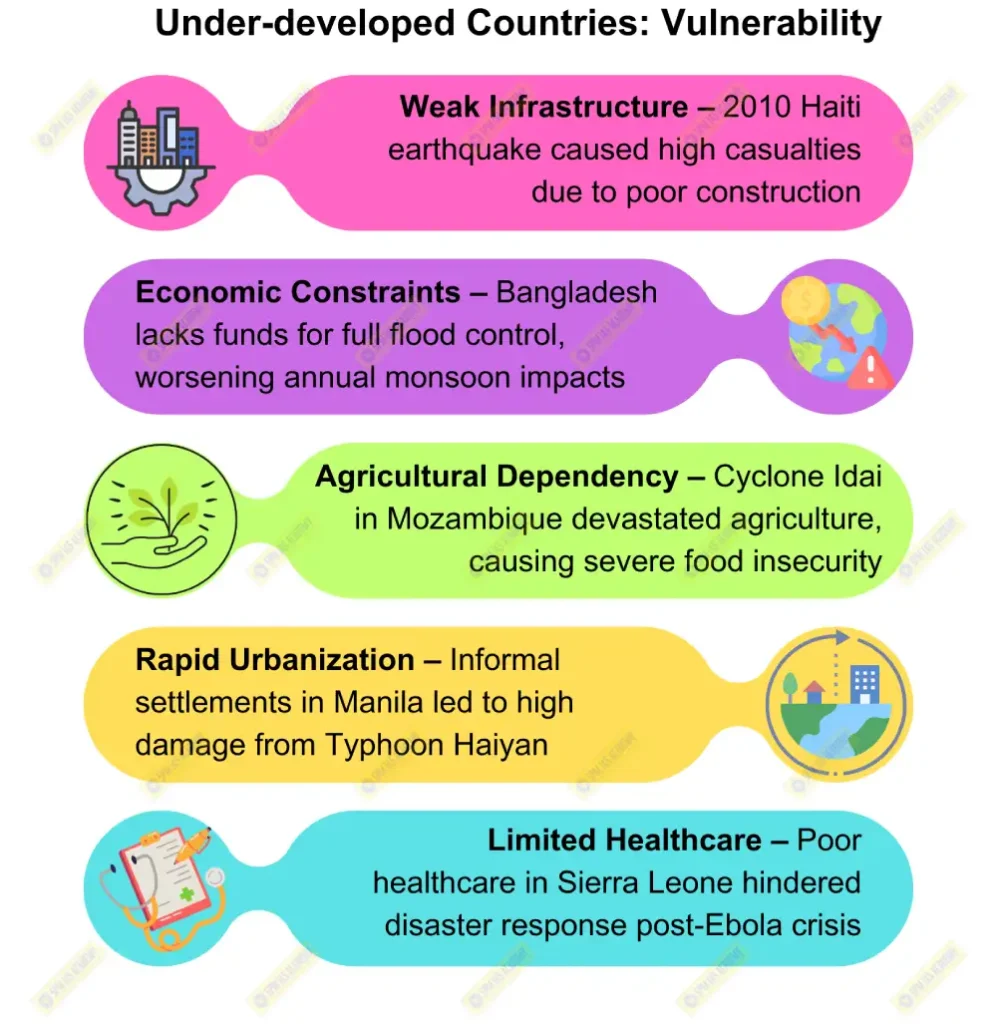India’s initiative for the Coalition for Disaster Resilient Infrastructure (CDRI), launched in 2019, is a global platform aimed at promoting resilient infrastructure to mitigate the impact of natural disasters, particularly in least developed and developing countries that are disproportionately affected by climate-induced calamities. With growing climate threats, CDRI embodies India’s commitment to fostering global resilience, sustainability, and preparedness.
Key Features of CDRI and Its Objectives
- Promoting Resilient Infrastructure: CDRI’s primary objective is to support member countries in developing disaster-resilient infrastructure. This includes strengthening buildings, transportation networks, power grids, and digital infrastructure to withstand natural calamities such as earthquakes, floods, and cyclones. Resilient infrastructure is critical to reducing both human and economic losses in vulnerable countries.
- Global Collaboration for Risk Reduction: CDRI fosters collaboration between governments, multilateral organizations, and private sector stakeholders to share technology, expertise, and best practices in disaster resilience. This global coalition seeks to democratize access to advanced infrastructure planning and risk management strategies, which are often out of reach for least developed countries (LDCs).
- Capacity Building and Research: CDRI focuses on building local capacity for disaster preparedness, especially in regions with high exposure to natural disasters but limited resources. It conducts research, develops frameworks, and provides training to equip policymakers and engineers with knowledge about disaster-resistant design and infrastructure planning.
- Climate Adaptation and Mitigation: With climate change escalating the frequency and severity of natural disasters, CDRI aligns with global climate adaptation goals. It provides a platform to integrate climate resilience into infrastructure, reducing carbon emissions while enhancing the durability and sustainability of essential public systems.

Impact of CDRI on Least Developed and Developing Countries
1. Enhanced Preparedness and Resilience:
- CDRI helps vulnerable nations prepare for climate impacts by embedding resilience into infrastructure development, thereby reducing recovery costs and saving lives. For instance, CDRI member countries in the Asia-Pacific region, which frequently face cyclones, have benefited from shared frameworks on cyclone-resistant infrastructure.
- Bhutan and Nepal, both CDRI members, have leveraged this collaboration to assess and enhance the resilience of their energy and transport sectors, reducing vulnerability to landslides and earthquakes.
2. Financial and Technical Assistance:
- The coalition provides financial and technical support to LDCs, which often lack the resources to build resilient infrastructure independently. Through partnerships with World Bank, UNDRR (United Nations Office for Disaster Risk Reduction), and Asian Development Bank, CDRI offers access to funding, disaster risk assessment tools, and technical expertise.
- For example, post Cyclone Amphan in 2020, India collaborated with Bangladesh (a CDRI partner) to rebuild cyclone-resistant infrastructure, underscoring the coalition’s role in fostering region-specific resilience.
3. Reducing Economic Losses:
- Natural disasters cause significant economic setbacks for developing countries. According to the World Bank, natural calamities cost low-income nations over $390 billion annually. By investing in disaster-resilient infrastructure, CDRI members can minimize these losses. In 2021, India emphasized the need for resilient infrastructure at COP26, highlighting that every dollar invested in resilience results in a $4 return in avoided economic losses.
4. Inclusive Growth and Sustainable Development Goals (SDGs):
- By enabling resilient infrastructure in developing countries, CDRI contributes to achieving SDG 9 (Industry, Innovation, and Infrastructure) and SDG 13 (Climate Action). It promotes inclusive growth by reducing vulnerability to disasters, ensuring that development gains are not erased by recurring calamities.
Challenges and Limitations
- Funding Constraints: Despite its ambitious goals, CDRI faces funding challenges, especially in mobilizing resources for low-income countries. Many LDCs require significant financial assistance to implement resilient infrastructure projects. CDRI’s 2021 budget highlighted the need for increased global funding to scale its impact, but contributions remain limited compared to the coalition’s goals.
- Implementation Barriers: In countries with limited governance capacity, translating CDRI’s recommendations into actionable plans can be challenging. Weak regulatory frameworks, bureaucratic hurdles, and lack of skilled manpower can hinder the effective implementation of resilient infrastructure projects.
- Climate-Induced Disasters and Rapid Urbanization: The increasing frequency of natural disasters due to climate change strains the coalition’s resources and capacity. Rapid urbanization in developing countries further complicates resilience planning, as unplanned infrastructure in cities often lacks the flexibility needed to withstand climate shocks.
- Dependence on International Support: Developing countries are heavily reliant on CDRI’s international members for resources and expertise, which could impact the coalition’s sustainability in the long term if support from major economies fluctuates. In this regard, a self-reliant model for resilience is critical for the coalition’s long-term success.
Future Prospects and Strategic Importance
- Expanding Membership and Partnerships: CDRI is seeking to expand its network by bringing more countries and international organizations into the coalition. Its strategic collaboration with organizations like UNDRR and the World Economic Forum strengthens its impact on global resilience strategies.
- Innovative Financing Models: There is growing emphasis on climate finance to support resilience initiatives in LDCs. India has advocated for increased contributions from developed nations and the private sector to ensure sustainable funding for CDRI projects.
Conclusion
India’s CDRI initiative marks a pivotal step in addressing the vulnerability of least developed and developing countries to natural disasters. As Prime Minister Narendra Modi highlighted at CDRI’s launch, “Infrastructure is not only about growth and prosperity; it is also about risk and resilience.” By fostering climate-resilient, inclusive infrastructure, CDRI aims to transform the global approach to disaster management, ensuring that the benefits of development are durable, equitable, and sustainable.
Through CDRI, India demonstrates leadership in addressing global climate challenges, yet the coalition must overcome significant funding and implementation hurdles to fully realize its potential in creating a more resilient, disaster-prepared world.












